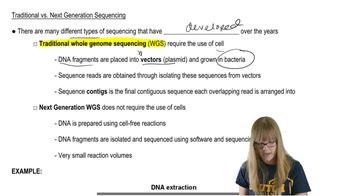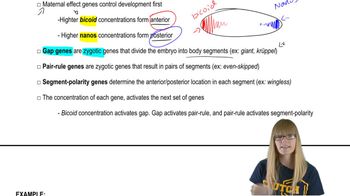How do we know which contigs are part of the same chromosome?
Table of contents
- 1. Introduction to Genetics51m
- 2. Mendel's Laws of Inheritance3h 37m
- 3. Extensions to Mendelian Inheritance2h 41m
- 4. Genetic Mapping and Linkage2h 28m
- 5. Genetics of Bacteria and Viruses1h 21m
- 6. Chromosomal Variation1h 48m
- 7. DNA and Chromosome Structure56m
- 8. DNA Replication1h 10m
- 9. Mitosis and Meiosis1h 34m
- 10. Transcription1h 0m
- 11. Translation58m
- 12. Gene Regulation in Prokaryotes1h 19m
- 13. Gene Regulation in Eukaryotes44m
- 14. Genetic Control of Development44m
- 15. Genomes and Genomics1h 50m
- 16. Transposable Elements47m
- 17. Mutation, Repair, and Recombination1h 6m
- 18. Molecular Genetic Tools19m
- 19. Cancer Genetics29m
- 20. Quantitative Genetics1h 26m
- 21. Population Genetics50m
- 22. Evolutionary Genetics29m
15. Genomes and Genomics
Sequencing the Genome
Problem 3c
Textbook Question
When the whole-genome shotgun sequence of the Drosophila genome was assembled, it comprised 134 scaffolds made up of 1636 contigs. How can physical gaps be closed?
 Verified step by step guidance
Verified step by step guidance1
Understand the concept of physical gaps: Physical gaps in genome assembly occur when there is missing sequence information between contigs that cannot be bridged by computational methods alone. These gaps need to be closed using experimental techniques.
Step 1: Use paired-end sequencing data. Paired-end reads provide information about the relative positions of sequences on the genome. If the paired reads span a gap, they can help identify the missing sequence and close the gap.
Step 2: Apply PCR amplification. Design primers flanking the gap regions based on the known sequences of adjacent contigs. Amplify the DNA in the gap using PCR and sequence the amplified product to fill the missing information.
Step 3: Utilize long-read sequencing technologies. Technologies like PacBio or Oxford Nanopore can generate longer reads that span gaps, providing direct sequence information for the missing regions.
Step 4: Perform chromosome walking or library screening. Use a genomic library to identify clones that contain sequences bridging the gap. Sequence these clones to close the physical gaps.
 Verified video answer for a similar problem:
Verified video answer for a similar problem:This video solution was recommended by our tutors as helpful for the problem above
Video duration:
1mPlay a video:
Was this helpful?
Key Concepts
Here are the essential concepts you must grasp in order to answer the question correctly.
Whole-Genome Shotgun Sequencing
Whole-genome shotgun sequencing is a method used to sequence an entire genome by randomly breaking the DNA into small fragments, which are then sequenced and assembled into a complete sequence. This approach allows for the rapid generation of genomic data, but it often results in gaps due to the random nature of fragment selection, necessitating further techniques to close these gaps.
Recommended video:
Guided course

Sequencing Overview
Scaffolds and Contigs
In genome assembly, contigs are contiguous sequences of DNA that are formed by overlapping fragments, while scaffolds are larger structures that consist of multiple contigs linked together. Scaffolds provide a more complete representation of the genome, but gaps may still exist between contigs, which can be addressed through additional sequencing or mapping techniques to improve assembly accuracy.
Recommended video:
Guided course

Traditional vs. Next-Gen
Gap Closure Techniques
Gap closure techniques involve various methods to fill in the physical gaps between contigs in a genome assembly. These methods can include targeted sequencing of the gap regions, using paired-end reads to bridge gaps, or employing long-read sequencing technologies that can span larger distances, thereby enhancing the completeness and accuracy of the genomic assembly.
Recommended video:
Guided course

Segmentation Genes
Related Videos
Related Practice
Textbook Question
441
views


